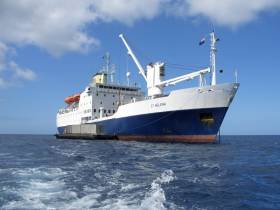Displaying items by tag: Final UKSt Helena voyage
#RMShelenaHome – RMS St. Helena, the passenger and cargo vessel which provides a lifeline to St. Helena, a British Overseas Territory, deep in the South Atlantic, completed her final ever voyage from the UK yesterday. The 4,500 mile voyage having taken two weeks, writes Jehan Ashmore.
The 1990 custom built RMS St. Helena or ‘RMS’ as she is affectionately known by the islanders or ‘Saints', made a historic once off visit to London. The 105m long vessel afterwards departed downriver from Tilbury on the Thames Estuary.
The St. Helena Line vessel’s voyage (no. 243) had made en-route calls to Tenerife in the Canary Islands and Ascension, also a UK overseas territory.
On board were 116 passengers, both islanders and tourists making one of the last voyages before she is decommissioned. Also the dog ‘Dusty’ a black labrador belonging to the island’s new governor was also conveyed.
Among the cargoes containing food, were 38 cars and a pair of fire engines from Yorkshire, as the Royal Mail Ship is the only means of transport available to St. Helena.
RMS St. Helena arrived as scheduled to anchor offshore off Jamestown, the capital of the island (population: 4,500). Residents and tourists disembarked by tender.
The 47sq mile territory is one of the most remote inhabited islands in the world, however a new airport, an island first, will change all that when it opens. Delays, however in beginning commercial flights to South Africa have led to an extension of voyages by the ‘RMS’ that will maintain the routine service that is to and from Cape Town.
After a career spanning just over a quarter century, RMS St. Helena, the 1,000th ship to be built by A&P Aberdeen, will then be sold. In that timeframe she made a once off charter cruise to Ireland in 1995, calling to Dublin and Cobh (Cork). The London registered 6,797 tonnes vessel made her only call to the UK capital earlier this month with a visit by Royalty.
Shipping services will continue, as AW Ship Management, which operates the RMS St. Helena, will continue operations albeit in the form of a container ship. This will be the M.V. St. Helena with a limited passenger capacity totaling a mere 8-10 persons.
























































